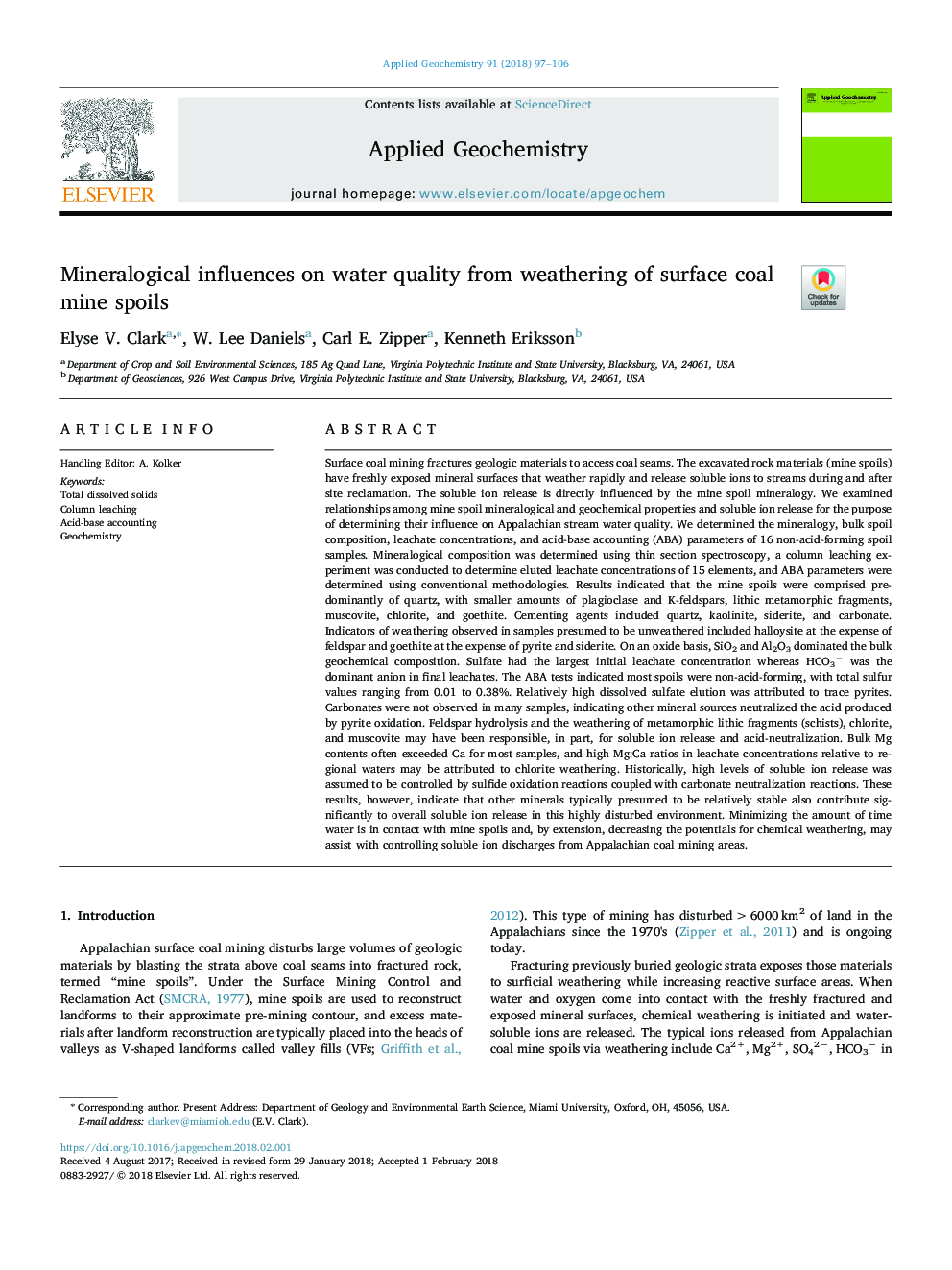| کد مقاله | کد نشریه | سال انتشار | مقاله انگلیسی | نسخه تمام متن |
|---|---|---|---|---|
| 8863155 | 1620200 | 2018 | 10 صفحه PDF | دانلود رایگان |
عنوان انگلیسی مقاله ISI
Mineralogical influences on water quality from weathering of surface coal mine spoils
ترجمه فارسی عنوان
اثرات کانه زیستی بر کیفیت آب از هوای ناشی از خرابی های معدن زغال سنگ سطح
دانلود مقاله + سفارش ترجمه
دانلود مقاله ISI انگلیسی
رایگان برای ایرانیان
کلمات کلیدی
جامدات جامد محلول، شستشوی ستون، حسابداری اسید، ژئوشیمی،
موضوعات مرتبط
مهندسی و علوم پایه
علوم زمین و سیارات
ژئوشیمی و پترولوژی
چکیده انگلیسی
Surface coal mining fractures geologic materials to access coal seams. The excavated rock materials (mine spoils) have freshly exposed mineral surfaces that weather rapidly and release soluble ions to streams during and after site reclamation. The soluble ion release is directly influenced by the mine spoil mineralogy. We examined relationships among mine spoil mineralogical and geochemical properties and soluble ion release for the purpose of determining their influence on Appalachian stream water quality. We determined the mineralogy, bulk spoil composition, leachate concentrations, and acid-base accounting (ABA) parameters of 16 non-acid-forming spoil samples. Mineralogical composition was determined using thin section spectroscopy, a column leaching experiment was conducted to determine eluted leachate concentrations of 15 elements, and ABA parameters were determined using conventional methodologies. Results indicated that the mine spoils were comprised predominantly of quartz, with smaller amounts of plagioclase and K-feldspars, lithic metamorphic fragments, muscovite, chlorite, and goethite. Cementing agents included quartz, kaolinite, siderite, and carbonate. Indicators of weathering observed in samples presumed to be unweathered included halloysite at the expense of feldspar and goethite at the expense of pyrite and siderite. On an oxide basis, SiO2 and Al2O3 dominated the bulk geochemical composition. Sulfate had the largest initial leachate concentration whereas HCO3â was the dominant anion in final leachates. The ABA tests indicated most spoils were non-acid-forming, with total sulfur values ranging from 0.01 to 0.38%. Relatively high dissolved sulfate elution was attributed to trace pyrites. Carbonates were not observed in many samples, indicating other mineral sources neutralized the acid produced by pyrite oxidation. Feldspar hydrolysis and the weathering of metamorphic lithic fragments (schists), chlorite, and muscovite may have been responsible, in part, for soluble ion release and acid-neutralization. Bulk Mg contents often exceeded Ca for most samples, and high Mg:Ca ratios in leachate concentrations relative to regional waters may be attributed to chlorite weathering. Historically, high levels of soluble ion release was assumed to be controlled by sulfide oxidation reactions coupled with carbonate neutralization reactions. These results, however, indicate that other minerals typically presumed to be relatively stable also contribute significantly to overall soluble ion release in this highly disturbed environment. Minimizing the amount of time water is in contact with mine spoils and, by extension, decreasing the potentials for chemical weathering, may assist with controlling soluble ion discharges from Appalachian coal mining areas.
ناشر
Database: Elsevier - ScienceDirect (ساینس دایرکت)
Journal: Applied Geochemistry - Volume 91, April 2018, Pages 97-106
Journal: Applied Geochemistry - Volume 91, April 2018, Pages 97-106
نویسندگان
Elyse V. Clark, W. Lee Daniels, Carl E. Zipper, Kenneth Eriksson,
